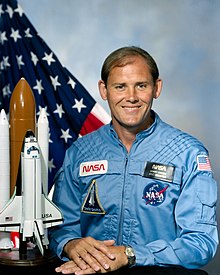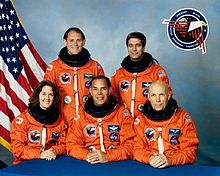Sonny Carter
Sonny Carter | |||||||||||||||||||||||||
|---|---|---|---|---|---|---|---|---|---|---|---|---|---|---|---|---|---|---|---|---|---|---|---|---|---|
 Carter's official NASA portrait, 1984 | |||||||||||||||||||||||||
| Born | Manley Lanier Carter Jr. August 15, 1947 | ||||||||||||||||||||||||
| Died | April 5, 1991 (aged 43) Brunswick, Georgia, U.S. | ||||||||||||||||||||||||
| Education | Emory University (BS, MD) | ||||||||||||||||||||||||
| Awards | Air Medal | ||||||||||||||||||||||||
| Space career | |||||||||||||||||||||||||
| Rank | Captain, USN | ||||||||||||||||||||||||
Time in space | 5d 0h 6m | ||||||||||||||||||||||||
| Selection | NASA Group 10 (1984) | ||||||||||||||||||||||||
| Missions | STS-33 | ||||||||||||||||||||||||
Mission insignia | |||||||||||||||||||||||||
| |||||||||||||||||||||||||
Manley Lanier "Sonny" Carter Jr.,
.Early life and education
Carter was born on August 15, 1947, to parents Manley L. Carter and Elizabeth C. Carter in
Carter received a Bachelor of Arts degree in Chemistry from Emory University in Atlanta in 1969, and a Doctor of Medicine degree from there in 1973. During his time at Emory, Carter was a brother in the Alpha Tau Omega fraternity. After completing Emory University School of Medicine in 1973, Carter completed internship in internal medicine at Grady Memorial Hospital in Atlanta.
Athletic career
Carter played collegiate
In 1974, Carter entered the
Carter logged 3,000 flying hours and 160 carrier landings.
NASA career
Selected by NASA in May 1984, Carter became an astronaut in June 1985, qualified for assignment as a mission specialist on future Space Shuttle flight crews.
Space Shuttle program

Carter was assigned as
At the time of his death in April 1991, Carter was assigned as mission specialist 3 on the crew of STS-42 Discovery, the first International Microgravity Laboratory (IML-1). His place was taken by Dave Hilmers.
Death
Carter died in the April 5, 1991, crash of Atlantic Southeast Airlines Flight 2311 in Brunswick, Georgia. He was aboard the commercial airplane traveling for NASA.[4] His wife Dana and two daughters, Olivia Elizabeth (born May 27, 1974) and Meredith Corvette (born December 3, 1976), were not on the flight.[5] Among the others who also died in the plane crash was John Tower, a former Senator from Texas.
Carter's death occurred on the same day as the launch of the Space Shuttle Atlantis on mission STS-37.
Organizations
Carter was a member of the Society of U.S. Naval Flight Surgeons, Sigma Delta Psi, Alpha Omega Alpha, Alpha Tau Omega, the Marine Corps Aviation Association, the Tailhook Association, and the Society of Experimental Test Pilots.
Special honors
- Air Medal
- Meritorious Service Medal
- Navy Achievement Medal
- Meritorious Unit Citation
- Marine Corps Aviation Association Special Category Award (1982)
- NASA Meritorious Service Medal (1988)
- NASA Space Flight Medal (1989)
Carter was the Guest of Honor at the 215th
Legacy

Having died in the line of duty for NASA, Carter's name was added to the Space Mirror Memorial at Kennedy Space Center Visitor Complex in Merritt Island, Florida. His name was the first added after the memorial's original construction.
After his death, his name was given to the
In 1989, Emory University inducted him in its Athletic Hall of Fame.

In 1992 he was inducted into the Georgia Aviation Hall of Fame.[7]
Sonny Carter Elementary School in Macon, Georgia, which opened in 1993, was named for Carter. The school motto is: "To Challenge the Edge of the Universe."
The Society of United States Naval Flight Surgeons (SUSNFS) bestows an annual "Sonny Carter Memorial Award" to the nominee with the most significant contribution to the health, safety and welfare of the operational forces by promoting communication and teamwork amongst the aeromedical community.[8]
Physical description
- Weight: 165 lb (75 kg)
- Height: 6 ft ½ in (1.84 m)
- Hair: Brown
- Eyes: Blue[9]
References
- ^ "Sonny Carter's biography" (PDF). NASA. April 1991. Retrieved November 17, 2020.
- ^ Sonny Carter at scouting.org Archived March 3, 2016, at the Wayback Machine
- ^ Manley Carter career stats, North American Soccer League, NASLJerseys.com
- ^ National Transportation Safety Board Brief
- ^ "Sonny Carter's family". Archived from the original on December 23, 2018. Retrieved October 9, 2015.
- ^ Honoring the true student athlete, Emory Magazine, Emory University, Winter 1997.
- ^ "Manley L. "Sonny" Carter Jr". Georgia Aviation Hall of Fame. Archived from the original on June 2, 2017. Retrieved October 9, 2018.
- ^ "Sonny Carter Memorial Award SUSNFS".
- ^ "Sonny Carter's physical description". Archived from the original on December 23, 2018. Retrieved October 9, 2015.
External links
- Astronautix biography of Sonny Carter
- Spacefacts biography of Sonny Carter
- Carter at Spaceacts Archived March 27, 2016, at the Wayback Machine
- Brunswick, GA Commuter Plane Crash Kills John Tower, Sonny Carter, and 21 others, Apr 1991 Archived November 28, 2021, at the Wayback Machine Article at GenDisasters.com.
- "Astronauts and the BSA". Fact sheet. Boy Scouts of America. Archived from the original on April 14, 2009. Retrieved September 6, 2006.
- "Distinguished Eagle Scouts" (PDF). Scouting.org. Archived from the original (PDF) on March 12, 2016. Retrieved November 4, 2010.

